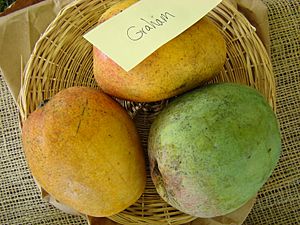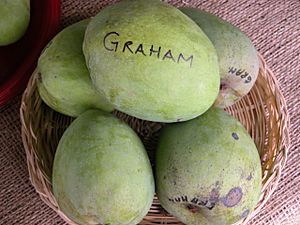Graham (mango) facts for kids
Quick facts for kids Mangifera 'Graham' |
|
|---|---|
 |
|
| Genus | Mangifera |
| Species | Mangifera indica |
| Cultivar | 'Graham' |
| Origin | Trinidad from 'Julie' seed. |
The Graham' mango is a special type of mango that first grew in Trinidad. It's known for its delicious taste and is a favorite among many mango lovers.
Contents
The Story of the Graham Mango
Where Did Graham Mangoes Come From?
The 'Graham' mango started as a tiny seed in Trinidad. It grew from a special mango called the 'Julie' mango. In 1932, this new mango variety was brought to the United States. The USDA helped introduce it through Florida.
Why Is Graham Popular?
The 'Graham' mango tree has become very popular in Florida. Many people like to grow it in their homes. This is because the fruit tastes great. Also, the tree is strong and can resist many plant diseases.
In 2008, the 'Graham' mango was chosen as a special mango at the Fairchild Tropical Botanic Garden's mango festival. It is also a popular fruit in the Windward Islands.
Where Are Graham Trees Grown Today?
Today, 'Graham' mango trees are planted in important places. You can find them at the USDA's special plant collection in Miami, Florida. They are also at the University of Florida's Tropical Research and Education Center in Homestead, Florida. Another place is the Miami-Dade Fruit and Spice Park, also in Homestead. These places help study and protect different plant types.
What Does a Graham Mango Look Like?
Fruit Appearance
The 'Graham' mango fruit has an oval shape. Its top part is rounded. Sometimes, it has a small bump on the side. When the fruit is ready to eat, its skin turns yellow. The skin can also feel a bit bumpy.
Inside the Fruit
Inside, the mango has bright orange flesh. It does not have any stringy fibers. The taste is rich and smells wonderful. It might have a slight resin-like scent. The fruit has one seed inside. This type of seed is called monoembryonic, meaning it produces only one plant from a single seed. 'Graham' mangoes usually ripen in Florida from June to August.
The Graham Mango Tree
Unlike its parent, the 'Julie' mango, the 'Graham' tree grows very strong and tall. It can reach over 20 feet high. It forms a round, thick leafy top.


